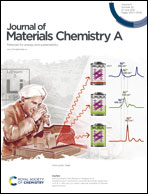A mixed ion-electron conducting carbon nanotube ionogel to efficiently harvest heat from both a temperature gradient and temperature fluctuation†
Abstract
It is of significance to develop efficient heat-to-electricity conversion technology for sustainable development because of the abundant waste heat on Earth. Waste heat can induce a temperature gradient in the environment, and the temperature fluctuates with time. Thermoelectric (TE) generators based on the Seebeck effect of electronic conductors under a temperature gradient can directly convert heat into electricity, but their performance is still too low for large-scale practical application. Here, we report mixed ion-electron thermoelectric converters (MTECs) using flexible quasi-solid ionogels consisting of an ionic liquid (IL), gelatin and single-walled carbon nanotubes (SWNTs). The ionogels are ionically and electronically conductive due to the ionic liquid and SWNTs, respectively, and they have very low thermal conductivity. The MTECs can convert heat into electricity from both the temperature fluctuation causing the ion accumulation variation of the ionic liquids and the temperature gradient inducing the Seebeck effect of SWNTs. The ratio of the optimal output power density (P) of the MTECs to the thermal conductivity (λ) of the active material is used to evaluate the TE performance. The P/λ value of the MTECs with optimal SWNT loading in the ionogel is about 7.7 times of that of the control TE generators with a SWNT film.



 Please wait while we load your content...
Please wait while we load your content...